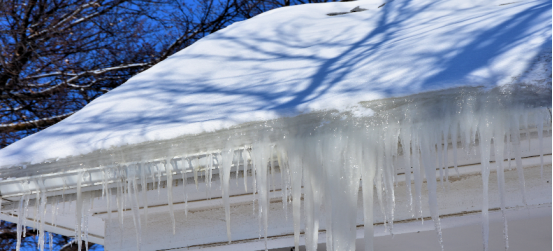THE LATEST IN ROOFING

The pooled water trapped behind the ice dam can work its way into porous roofing materials like asphalt shingles, wood shake or clay tiles. When the water refreezes, it expands and puts substantial pressure on porous roofing materials, causing them to crack or split.
While ice dams can cause considerable damage to the roof itself, the pooled water can also penetrate the underlying roof deck resulting in secondary damage to walls, ceilings, insulation, siding and gutters.
For example, if water penetrates the attic, stains to exterior walls and damage to insulation ceiling finishes are major risks. This also makes for the perfect environment for mold and mildew to flourish.
Since ice dams are caused by inconsistent roof surface temperatures, it’s critical to keep the temperature of the roof consistent from the highest ridge to the lowest eave.
A well-ventilated roof will draw the freezing outside air into the space beneath the roof and prevent the air in the attic from warming above the freezing point.
The issue with traditional roofing materials like asphalt shingles, wood shake, and clay tiles is that maintaining a consistent temperature is difficult because they lay flat and are installed directly on the roof deck. There is no space for air, insulation or anything else in between.
Since a well-ventilated roof requires airspace between the roof deck and the roof surface, look for a roofing material that can be installed in one of two ways:
· On battens.
· Directly to the roof deck and has built-in airspace of at least ¾”.
What you don’t want is a roofing material that is attached to the deck without any underlying airspace. Asphalt shingles, for example, are nailed directly to the roof deck and don’t provide any space for airflow.
Metal roofing, on the other hand, can be installed on either battens or direct-to-deck with the critical ¾” airspace required for proper ventilation.
The airspace makes your metal roof an excellent investment for increasing energy efficiency year round, since allowing heat to radiate up and away from the home in warm weather also reduces the cooling load of the home.
A metal roof is also non-porous, impervious to snow or water, and resistant to cracking, warping and buckling.
While the roofing material plays a major role in preventing ice dams, there are other steps homeowners can take to reduce the chances of ice dams forming, as recommended by the National Weather Service:
· Thoroughly clean all leaves, sticks, and storm debris from your home's gutters and downspouts. This permits melting roof snow to flow undeterred into gutters and through downspouts.
· Make every effort to keep the snow amount on your roof to a minimum. Long-handled devices called "roof rakes" let you stand on the ground and pull the snow off the roof. Keeping heavy snow loads off your roof reduces the chances of both ice dam formation and roof failure due to the snow weight.
· Throughout the winter season, keep gutters and downspouts clear of snow and icicles.
· Evaluate the insulation and ventilation in your attic. Most experts agree the R-value of attic insulation should be at least R-30 (R-38 is preferable in northern climates).
· Good continuous airflow from under the eaves or soffit area along the underside of the roof and out through the roof vents is essential. This is why metal roofing systems are one of the best solutions for dealing with ice dams. The ridge venting allows the attic air to stay cold enough to prevent or minimize the freeze/thaw cycle on the roof.



REQUEST A QUOTE
Copyright © Hangzhou Singer Building Materials Co., Ltd. All Rights Reserved |
Sitemap
| Powered by 
SEOKeywords:Roof Tile ManufacturerRoof Shingle ManufacturerAsphalt Shingle SupplierRain Gutter CompanyShingle Roofing CompanyWaterproof Tape For RoofPressed Steel Roofing TilesRain Gutter SystemGray Asphalt ShingleStone Coated Metal Roofing Manufacturer